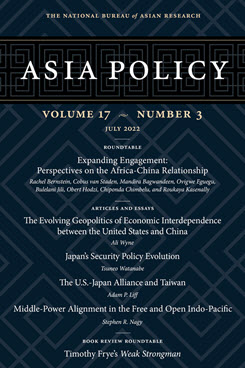The U.S.-Japan Alliance and Taiwan
This article analyzes the historical evolution of Japan’s positions, posture, and policies relevant to a possible conflict across the Taiwan Strait, including the potential roles of the U.S.-Japan security alliance and Japan’s Self-Defense Forces.
EXECUTIVE SUMMARY
MAIN ARGUMENT
In April 2021, Japan’s then prime minister Yoshihide Suga and U.S. president Joe Biden made global headlines when they jointly “underscored the importance of peace and stability across the Taiwan Strait and encouraged the peaceful resolution of cross-Strait issues”—the first such reference in a summit-level statement since 1969. This statement catalyzed a striking degree of public discussion in Japan and expressions of concern about cross-strait stability from Japanese leaders. It also elicited widespread, though often misleading or inaccurate, assertions overseas that Japan’s position vis-à-vis a “Taiwan contingency” had abruptly or radically transformed. Especially given the proximity of Japan (and U.S. military bases in Japan) to Taiwan, soberly appreciating the complexity and incremental evolution of Japan’s nuanced and intentionally ambiguous positions and policies, as well as its unique domestic constraints, is critical. Doing so is especially crucial for policymakers to accurately assess the status quo, manage expectations within and beyond the alliance, and ensure sound decision-making as the cross-strait deterrence challenge seems all but certain to deepen in the years ahead.
POLICY IMPLICATIONS
- Japan’s decades-old, intentionally ambiguous official posture toward a possible Taiwan Strait contingency has not radically changed. Any action Japan would take in a possible crisis will depend on top-level political judgments about the particular contingency’s nature, how it began, how Taipei and Washington have responded, and the perceived threat to Japan itself.
- Ambiguity—by design—should not be misunderstood as apathy or ambivalence in Tokyo about democratic Taiwan’s future or cross-strait peace and stability. Recent developments suggest a new sense of urgency and openness to deepen contingency and bilateral planning with Washington to enhance deterrence and to prepare options if deterrence fails. Though not originally motivated by a possible Taiwan contingency, Japan’s national security and alliance reforms over the past decade have expanded the options for allied cooperation and Japan’s potential role(s) in the event one occurs.
- Important constraints on Japan are still apparent. It remains an open question how—and how quickly—Japan’s leaders could respond to use of force by China against Taiwan and what consequences any indecision could have on Japan’s and the alliance’s response or how a conflict plays out.
Adam P. Liff is an Associate Professor of East Asian International Relations at Indiana University’s Hamilton Lugar School of Global & International Studies and Director of its 21st Century Japan Politics and Society Initiative (United States). He is also a Nonresident Senior Fellow in Foreign Policy at the Brookings Institution.
About Asia Policy
Asia Policy is a peer-reviewed scholarly journal presenting policy-relevant academic research on the Asia-Pacific that draws clear and concise conclusions useful to today’s policymakers. Asia Policy is published quarterly in January, April, July, and October and accepts submissions on a rolling basis. Learn more


